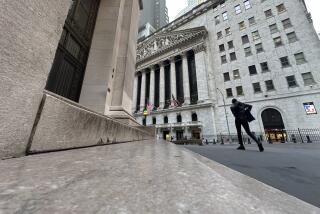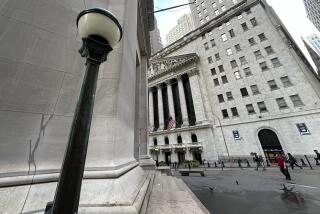A Record-Breaking Frenzy : Stocks Gyrate, Bonds Gain on Busiest Day Ever
- Share via
U.S. stocks took a heart-stopping bungee jump Tuesday that carried the Dow Jones industrial average all the way from a 166-point slide to a 9-point gain. The frenzy spurred the busiest day in market history.
Bonds rallied as recent market losses and a government report on consumer prices bolstered the view that inflation won’t surge in coming months.
The Dow industrials closed at 5,358.76, still 7.2% off May’s record of 5,778.
The rebound came as declining bond yields and better-than-expected earnings from Eastman Kodak and Caterpillar eased concern that corporate profits will suffer further this year, encouraging investors once more to look at a slump as a buying opportunity.
“It’s time we have ice water in our veins,” said Mark Donovan, money manager at Boston Partners Asset Management, which has $6.2 billion in assets. “People have been frozen in the headlights the last two weeks as fear took over.”
While stocks rebounded from their lows on the day--at one point, the Dow industrials sank to their lowest point in six months--the broader market stayed down. The Standard & Poor’s 500-stock index fell 1.43 points to 628.37, and the Nasdaq composite index dropped 6.72 points to 1053.47.
A record number of shares changed hands on both the New York Stock Exchange and Nasdaq. On the Big Board, the 682.98 million shares traded topped the Dec. 15 record of 636.8 million, while Nasdaq’s 828.3 million surpassed the May 7 record of 806.5 million.
Trading got so hectic that NYSE circuit breakers, limiting some computer-guided trades, were triggered both when the Dow rose 50 points and when it fell 50. It was only the second time that has ever happened; the other time was in May.
Computer-related shares, which have been among the market’s worst performers since Digital Equipment warned of lower profit two weeks ago, helped lead Tuesday’s rebound. The Morgan Stanley high-tech index jumped 3.60 points to 284.38.
A round of computer-guided buy orders, which enable investors to move millions of dollars in or out of the stock market in a short period, helped fuel the subsequent recovery, traders said.
“We saw some panic selling, and then people stepped in,” said Louis Todd, head of equity trading at J.C. Bradford & Co.
Investors said the recent decline may have been overdone. On Monday, the Nasdaq’s 3.91% drop was its biggest in almost five years, and the Dow industrials’ 2.92% decline was its sharpest since March 8, when bond yields soared after unexpectedly strong jobs growth.
Stocks got some help from a government report that showed that consumer prices rose last month by the smallest amount in seven months. The consumer price index climbed just 0.1% in June, below economists’ forecast of 0.2%, boosting optimism that inflation won’t accelerate and cause interest rates to rise.
The benchmark 30-year Treasury bond gained, with the yield falling to 7.02% from 7.07%.
Some mutual fund companies, including Fidelity Investments, reported an increase in shareholder withdrawals. “We’ve seen a modest level of redemptions from equity funds over the past few days,” said Robyn Tice, a Fidelity spokeswoman. She wasn’t more specific.
Officials at T. Rowe Price Associates and Stein, Roe & Farnham also reported “modest net outflows” and an increase of investing in low-risk money market funds.
“We’re in for several more days of volatility” as corporate earnings reports exceed and fall short of estimates, said Timothy Heekin, head of equity trading at Salomon Brothers.
Among Tuesday’s highlights:
* Some key tech issues that got hammered in recent sessions bounced back. Hewlett-Packard rose 2 3/4 to 41, Compaq Computer gained 3 1/8 to 44 5/8, Microsoft jumped 4 3/4 to 115 3/8 and IBM added 4 1/4 to 95 1/8.
After the close of trading, Intel, the world’s biggest maker of semiconductors and a computer industry bellwether, reported better-than-expected second-quarter earnings. Shares rose as much as 2 1/8 in after-market trading to 72 1/8.
* Leading the Dow average higher, Kodak rose 2 7/8 to 69 7/8 and Caterpillar jumped 2 5/8 to 66 3/8.
* Stocks suffered a midday plunge, driven by disappointing earnings reports from Wells Fargo, which dropped 1/2 to 227 5/8. But strong earnings helped Chase Manhattan, up 7/8 at 66 3/4, and Citicorp, up 3/4 at 77 3/8.
* Drug shares slid on Eli Lilly’s disappointing earnings report. Eli Lilly lost 2 5/8 to 56 7/8, Merck fell 1 1/8 to 61 1/8, Schering-Plough dropped 1 3/8 to 58 1/2 and Pharmacia & Upjohn lost 1/4 to 40 7/8. Pfizer bucked the trend, rising 7/8 to 72 1/4.
* Oil shares were among the day’s biggest losers and helped lead the stock market’s early-afternoon retreat. Mobil fell 3 3/8 to 111 5/8, Chevron slipped 1 1/8 to 58 1/8, Amoco dropped 1/2 to 68 1/8 and Texaco dropped 7/8 to 86 3/8.
Overseas, Mexican stocks mirrored Wall Street’s spectacular comeback and closed higher after being down more than 3%. Mexico City’s Bolsa closed 0.955% higher at 2,944.39.
*
“We’re in a bear market. It’s that simple.” Bob Buettner, Manager of the Lindner Bulwark Fund.
*
“Is it a correction? Well, that doesn’t do it justice.” Hugh Johnson, Chief investment officer at First Albany Corp.
*
“We don’t have any historical signs that the bull market is over.” Larry Rice, Chief investment officer at Josephthal, Lyon & Ross
*
Markets Coverage:
* Market’s turnaround raises hopes that share prices may be stabilizing after the recent slide. A1
* What’s eating the stock market? Confusion stemming from historic change. A1
* There’s a lot at stake for brokers in calming investor fears. D3
* There were signs that the bull market was headed for a wild ride. D3
(BEGIN TEXT OF INFOBOX / INFOGRAPHIC)
Is it over?
The Standard & Poor’s 500 index of blue-chip stocks sank as low as 605.88 on Tuesday before resurging. At the low the index was off 10.7% from its 1996 record closing high--a significant pullback in a bull market by any measure. The index ended the day at 628.37, which still leaves it down 7.4% from its 1996 high.
Biggest S&P; Declines Each Year Since 1974
1974: -37.6%
1987: -33.5%
1996: -7.4%
How Key Stocks Fared
*--*
Tues. Decline Stock close from peak Exxon $86.38 -4.2% Coca-Cola 46.13 -7.5% Merck 61.13 -14.4% Alcoa 55.50 -16.2% Goodyear 43.50 -17.9% Sears 43.75 -18.8% GM 47.00 -19.1% AT&T; 55.50 -19.4% Disney 56.00 -19.9% McDonald’s 43.25 -20.3%
*--*
Source: Standard & Poor’s Corp.
More to Read
Inside the business of entertainment
The Wide Shot brings you news, analysis and insights on everything from streaming wars to production — and what it all means for the future.
You may occasionally receive promotional content from the Los Angeles Times.










